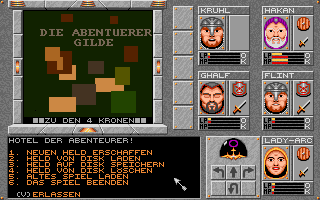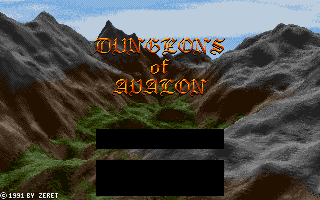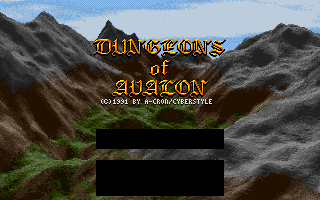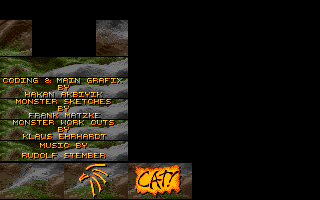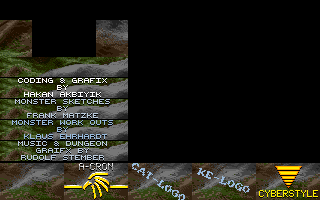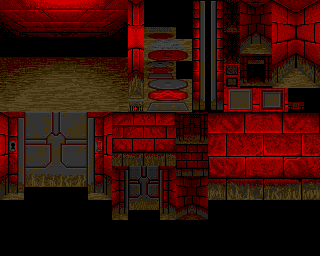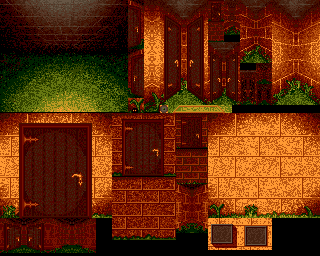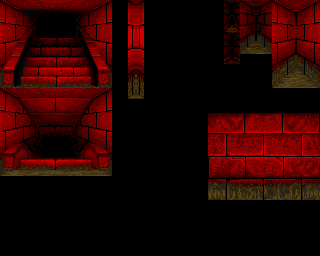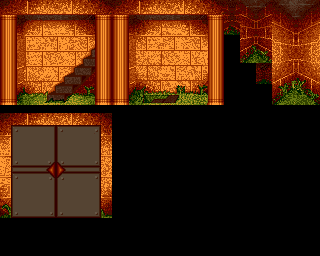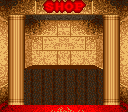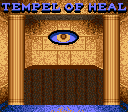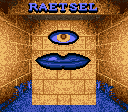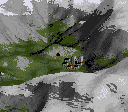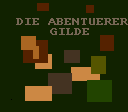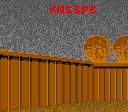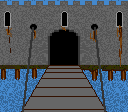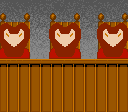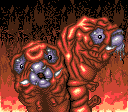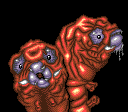Proto:Dungeons of Avalon
This page details one or more prototype versions of Dungeons of Avalon.
A prototype build of Dungeons of Avalon, dated 8 May 1991. It has many of the core features, but less impressive graphics and none of the dungeons are complete.
Contents
Provenance
In October 1991, an early prototype of the first Dungeons of Avalon game was published by popular Amiga scene group Skid Row. An included intro and cracktro refer to the disk as "Dungeons of Avalon Preview", and credit the supplier as one "S.S.R." File dates narrow down the release to 1 October 1991.
Based on file dates, the game prototype itself was built on 8 May 1991, about nine months before the final game build of 17 February 1992. It's unclear how the build was leaked. It may have been a progress report submitted to the publisher, as at least one Amiga magazine was believed to have a staffer who leaked review copies to pirate groups. Dumpster diving was also not unheard of.
Graphics
Title Screen
| Final titlescreen | Proto titlescreen |
|---|---|
| Final titlescreen | Proto titlescreen |
|---|---|
The title screen in the prototype credits "A-CRON/CYBERSTYLE", referencing the groups of coder Hakan Akbiyik and musician Rudolf Stember, respectively. A riddle in the game refers to the duo by the "CYBER-CRON". The final game credits the group under their newer name, "ZERET".
Dummy logos appear for the "CAT!" logo, for monster sketch artist Frank Matzke, and for Klaus Ehrhardt's logo. The final game has no logo for Klaus Ehrhardt, and displays both Akbiyik and Stember under the Zeret logo. The final game also changes Akbiyik's credit from "CODING & GRAFIX" to "CODING & MAIN GRAFIX", while Stember's credit goes from "MUSIC & DUNGEON GRAIFX" (sic) to simply "MUSIC", since all of the dungeon art would change in the final release.
A unique feature to the prototype is that when the player clicks to proceed on the title screen, the mountains palette-shift to white. This is mentioned in the lore, and the mountains surrounding the city Ghale are depicted as snowy.
The title screen music is also omitted in the prototype.
Dungeon Graphics
| Final dungeon gfx | Proto dungeon gfx |
|---|---|
| Final dungeon gfx | Proto dungeon gfx |
|---|---|
The original dungeon art is credited to Rudolf Stember. It changes completely in the final release. Doors were generally wooden hinged doors in the prototype; these change to vertical sliding doors, which are more easily animated.
None of the final game's dungeon levels were completed at this point, only two test levels.
A small difference is that tile 15 is used for the walls, instead of 16 as in the final game. In the final, 15 is used for loose stone walls, which look and behave identically to the usual type. Dungeons of Avalon II uses it for forcefields.
Spritesheet
| Final spritesheet | Proto spritesheet |
|---|---|
Embedded in the main game executable is a 320x200 32-color spritesheet very similar to the one included in the final release. In addition to various small changes to sprites, there are some notable differences.
All eight playable character portraits are there, as well as the NPC pirate Beard. However, the murderer Hanibal and bard Clint are not yet added.
Several items are notably omitted. The internal item list only includes 60 items instead of the final 81, meaning that they map 1:1 with the 60 sprites. Item 10 is "LEER", "empty", and in the final release that sprite slot would be used for the empty left hand. All spell scrolls are missing, as are The Rune, Anti-Aura, the skull, Killersword, and all of Arc's equipment. A pair of what appear to be nunchucks (a monk weapon, perhaps), named "SCHLAGSTÖCKE", appear in the slot later used by Knight Armour. Most of these items' names appear later in the list in the final version.
A few pieces of the main interface were moved out to an external file for lack of space. In the prototype, the cursor pad and inventory loadout were in the internal spritesheet. These were moved out to the files PART_D and PART_E (for German and English, respectively).
Status icons for ongoing spell effects included an animated flickering candle and a magic ring. Light sources, perhaps, were intended to play a more important role. The mapping spell icon had not yet been added.
Notably, map icons for all of the tile types already existed at this point, suggesting the in-game map spell was already intended, as were most of the tile IDs.
Town Graphics
| Image | Description |
|---|---|
| Shop. In the prototype, the shop in Ghale is Rudi's, and the H'Khan shop is Robin's. The final game makes H'Khan the first shop and switches the shops so that Rudi's is still the first shop you encounter. Rudi is named for Rudolf "Rudi" Stember, the game's musician. Robin is probably named for Robin Stember, another Cyberstyle member. | |
| "Tempel of Heal". The Ghale temple is called "Ara's Tempel"; in the final release, it's "Fisch's Tempel". Ara is the name of a founding member of demoscene group Argon, of which Rudolf Stember was a member. | |
| "Rätsel". Riddle giver. | |
| The City Ghale. In the prototype, Ghale is the first city, and H'Khan the second. Both use the same graphic. Like the title screen, it appears to have been generated with Vista, a 3D landscape generator. | |
| The Adventurer's Guild, aka the inn. In the final version, this slot is used for the City H'Khan graphic. The Ghale inn is called Zu Den 4 Kronen (To the 4 Kings), whereas the final renames it to Zum Totenschädel (To the Skull). | |
| "Kneipe", the tavern. In the prototype, you can visit the tavern to order drinks, listen to music, or talk to the landlord. The taverns are known as Zum Roten Drachen in Ghale, and Zur Gelben Perle in H'Khan. In the final version, the latter becomes Zur Blauen Perle, but it isn't visible since the tavern feature was removed. | |
| The castle. It's referred to as Rhateph's Schloss, rather than Rhateph's Burg as in the final. If you try to enter, it says "DIE WACHEN LASSEN EUCH NICHT DURCH.IHR HABT DIE LETZTE AUSGABE DER AMIGA-FUN NICHT GEKAUFT GEHABT." - "The guards won't let you through. You didn't buy the latest issue of Amiga Fun." This suggests that the game was always intended to be made for the German magazine's coverdisk. | |
| The Wise Three. Referred to as Die Beförderer (The Promoter), rather than Die Weisen Drei as in the final. |
The name for the dungeon is "DAS DUNGEON", rather than "DER DUNGEON" as in the final.
Monster Graphics
The only monsters whose art appears in the prototype are the first three: Thorndragon, Worm, and Troll. The other monster entries are empty slots. Of the three, Thorndragon and troll are byte-for-byte identical to the final game, but the Worm has a different background.
| Final worm graphic | Proto worm graphic |
|---|---|
| Name | Notes |
|---|---|
| THORNDRAGON | Occupies first monster slot in final game, but monster is unused. Monster art already included. |
| HELL-WORM | Occupies second monster slot in final game. Monster art already included. |
| TROLL | Occupies third monster slot in final game. Monster art already included. |
| SILLY WALKER | Fourth monster slot replaced with Silly Guard in final game. |
| GREEN DRAGON | Occupies fifth monster slot in final game. |
| RED DRAGON | Final game includes a creature called Fire Dragon, which is a palette-swap of the Green dragon. |
| SKELLETON | A Skelleton (sic) creature appears in Dungeons of Avalon II. The skeleton art is used in the final Dungeons of Avalon for the final boss. |
| MASTER-TROLL | Appears as Master Troll in final game. |
| MAGICIAN | Appears in final game. |
| MASTER MAGICIAN | Creature named Master Mage is an unused creature in Dungeons of Avalon. |
| WIZARD | No such creature appears in final game. |
| MASTER WIZARD | No such creature appears in final game. |
The text "MONSTER GALLERY!" doesn't appear in the prototype.
Spells
Only 16 spells are named. The final game has 43. Only a few of the proto spells appear in the final game.
| Proto spell | notes |
|---|---|
| .............. | 14-character dummy entry to show the maximum spell name length. |
| HEILIGES LICHT | Holy Light. |
| KRULL AUGEN | Krull Eyes. No idea what a krull is in this context. |
| MAG. PORTAL | Mag. Portal. Presumably a spell allowing return to |
| MAG. RÜSTUNG | Magier Rüstung. Appears in final game. |
| MAG. AUGE | Magier Auge. Appears in final game. |
| HAND AUFLEGEN | Lay on Hands. The name of a paladin healing ability in D&D. |
| HAND AUFLEGEN2 | Lay on Hands 2. |
| ALLHEILUNG I | All Healing 1. |
| ALLHEILUNG II | All Healing 2. The final game only has one Allheilung spell. |
| RESTORATION | |
| EIS SCHOCK | Ice Shock. The final game has Eisatem, Eisstare and Schock, but no spell by this name. |
| FEUER BLITZE | Fire Bolt. |
| STURM FAUST | Storm Fist. There is a spell in the final game called Sturmfaust. |
| DRACHEN ATEM | Dragon Breath. |
| TELEPORT | |
| UNSICHTBARKEIT | Invisibility. |
Changed Items
A few items' names changed:
| Final | Proto |
|---|---|
| LINKS | LEER |
| BIENENRING | LICHT RING |
| STEINRING | GHAL'S RING |
| SILBERRING | PERL'S RING |
| FUERDOLCH | FUER-DOLCH |
| RUBINDOLCH | RUBIN-DOLCH |
| HEILTRANK | TRANK |
| ANTIGIFTTRANK | TRANK |
| TODESBRINGER | TODES BRINGER |
Characters
The characters included on the disk are Hakan, Ghalf, Flint, Lizzy, Lady-Arc, Ghatum, and ZF. Skidrow's release adds two of their own characters, Arnd and LLL.
New characters start at level 0. This changes in the final game, where the start at level 1.
Characters are stored in 60 bytes. In the final release it's 74. Some of the additional bytes are used to store spell level, armor class, and attack stat.
One of the game's riddles asks "What is the name of my grandfather?" The answer is "Sefer Salap". The phrase SEFERSALAP is used by the game as a password to encrypt character sections in save game files, in order to protect them from save game editing. SEFERSALAP is XOR'd with the data.
Other Details
Many files on the disk are compressed using Powerpacker, which can be identified as such by their first four bytes, PP20. Such compression would be necessary to fit the game on one disk for distribution as a coverdisk. The final version obfuscates the compression format by changing the magic bytes to XX50, which would be enough to foil casual attempts to extract the game graphics.
The game manual was not included in this release, but the manual in the final release includes several references that reflect the prototype build instead of the final:
- The good wizard is originally named Arakus, not Kham. The change is consistent with renaming Ara's Tempel to Fisch's Tempel, suggesting perhaps that the coder intended to remove references to demoscene member Ara. However, the items Ara's Shield and Ara's Armour are still in the game, and they are still mentioned in the manual.
- The lore mentions a wizard bringing winter to the kingdom, which reflects the palette swap in the prototype's title screen.
- The lore mentions that five heroes volunteered to defeat the Dark Lord. The prototype only has a party size of five, in order to leave room for the movement controls. The final game rearranges the layout and increases the party size to 6.
- The art of the City Ghale in a valley makes fits with the lore which describes it as separated from the City H'Khan by a mountain, and the two are linked via a dungeon.
The UI layout is different. The shop sells a variety of high-end items.
